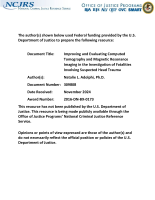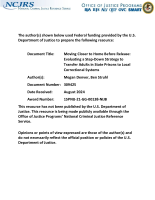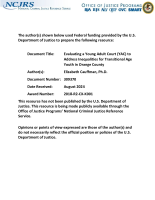Adults (18+)
Dual Pathways of Concealed Gun Carrying and Use from Adolescence to Adulthood over a 25-year Era of Change
When Is Online Sexual Solicitation of a Minor Considered Sexual Abuse? Recommendations for Victim Prevalence Surveys
Improving and Evaluating Computed Tomography and Magnetic Resonance Imaging in the Investigation of Fatalities Involving Suspected Head Trauma
Developing a Model for Providing Feedback to Reporters of Elder Abuse
Adolescent Mental Health and Resilience Before and During the COVID-19 Pandemic
Law Enforcement Response to Persons with Intellectual and Developmental Disabilities Identifying High-Priority Needs to Improve Law Enforcement Strategies
"Philadelphia Focused Deterrence Findings from the Impact Evaluation"
Childhood Maltreatment and Biological Aging in Middle Adulthood: The Role of Psychiatric Symptoms
IS2aR, a Computational Tool to Transform Voxelized Reference Phantoms into Patient-specific Whole-body Virtual CTs for Peripheral Dose Estimation
Outcomes Associated with Arrest for Domestic Violence: A Systematic Review and Meta-Analysis
Quantitative Evaluation of Hemp-Derived Vape Products for Accurate Labeling, Identification of Unknowns, and Stability
SERIOUSNESS OF CRIMES - NORMATIVE STRUCTURE AND INDIVIDUAL DIFFERENCES
Spatial Inequalities Among Urban Probation Populations: Supervision, Safety, and Ecological Considerations
Development Modeling of Phormia regina (Diptera: Calliphoridae)
Persistence and Desistance across Generations: A Longitudinal Investigation
Investigations Toward Development of a Technique for Rapid Identification of Forensically Relevant Necrophagous Beetle Species for Postmortem Interval Determination
Moving Closer to Home Before Release: Evaluating a Step-Down Strategy to Transfer Adults in State Prisons to Local Correctional Systems
Evaluating a Young Adult Court (YAC) to Address Inequalities for Transitional Age Youth in Orange County
Identifying High-Priority Needs to Improve Data and Metrics in Policing
Safe Transitions for Teens
Adult Children of the Prison Boom: Family Troubles and the Intergenerational Transmission of Criminal Justice Contact
Understanding the Impact of COVID-19 on Victim Services
The COVID-19 pandemic had a detrimental impact on communities across the nation and significantly affected various aspects of individuals’ lives. One of the negative impacts was an increase in gender-based violence accompanied by shifting barriers to accessing services and support. Victims and victim service providers faced various challenges dealing with the increase in need for services, navigating barriers to help-seeking, and addressing logistical issues.
Review the YouTube Terms of Service and the Google Privacy Policy





